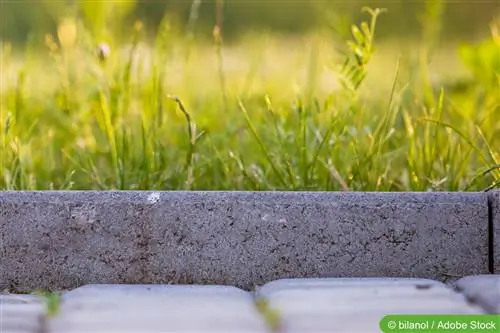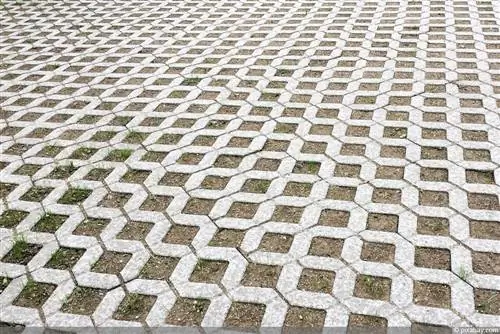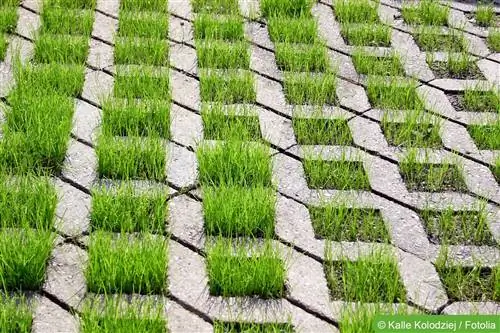- Author admin [email protected].
- Public 2023-12-17 03:39.
- Last modified 2025-01-24 12:45.
Edging stones can not only be used to delimit lawns and beds, but they can also form the edge of garden paths. Edging stones are also suitable for finishing off paved areas, e.g. a terrace or a barbecue area.
If you want to lay edging stones in your garden yourself, you should know how to lay them correctly and what to pay attention to. You can find more information and detailed instructions for laying edging stones in the garden below.
What functions do edge stones fulfill?
They are particularly suitable for creating a visibly clear separation between the lawn and the garden path or terrace as well as between beds and lawns. If they are well placed, they prevent the garden paths from becoming overgrown with grass and therefore help to keep the paved areas clean. They are also useful for lawn care by keeping garden soil where it belongs.
They are also used to border driveways. In addition to the functions of limitation and stabilization, edge stones also fulfill another important task, namely stabilization, for example in the case of a gravel border around the house or to secure an embankment. They can also be used in the garden as steps or in the form of a small bench by the garden pond.
What materials are they available in?
Edging stones are elongated borders that are a maximum of one meter wide and are available in a wide variety of materials, for example concrete or natural stone such as granite, sandstone or limestone. There are also different laying techniques to create clear lines between the individual areas and a pleasant atmosphere in your garden.
Concrete stones are generally used more often because they have a longer lifespan and are also easier to lay. Therefore, concrete edging stones are a good choice, especially for do-it-yourselfers who are working with edging stones for the first time, in order to set the stones precisely in just a few steps.
The right choice of stones
Before laying the edge stones in the garden, it is important that you first think about what the stones will be used for. This determines the strength of concrete edging stones in particular. If you want to create a garden path or a smaller area for a garden shed, stones with a thickness of 4.5 to 5 cm are completely sufficient. For larger paving areas with high loads, stones with a thickness of 6 cm should be used. This strength is no longer sufficient for curbs that are used for an entrance and are regularly driven over. For this it is better to use so-called deep shelves, which are between 8 and 10 cm thick depending on the load.
It is also important to think beforehand about which edging stones look best in your garden. You can get some ideas for this from your nearest garden center or building materials store. Various models are exhibited there and you can get your own idea of the shape and appearance of the different variants. Once you have decided on a variant, all you have to do is calculate how many meters of stones you need. You can then purchase the required quantity and have it delivered or collect it yourself.
What materials are needed for installation?
- Edging stones in the required quantity
- Gravel or concrete as a base
- Guideline or mason's line
- Wooden sticks and spirit level
- Spade
- rubber hammer
How to lay your edge stones correctly
If you want to delimit a lawn or terrace with edge stones, then you should make sure to place the stones as precisely as possible. For this reason, the use of a spirit level and a guide line is necessary.
Exactly how you should proceed when laying the stones is listed step by step below:
- Mark a straight line using a spirit level and wooden sticks.
- Attach the string to these wooden sticks, which will serve as a guide for a straight line on the one hand and for height on the other. Make sure that the cord is always the same height.
- Now the trench can be dug and the stones can be set in concrete.
- To do this, first dig a trench along the guideline. This should be at least a spade's length wide and approximately 20 centimeters deep.
- Now fill the trench halfway with moist concrete and place the stones along the guide line.
- Use a rubber mallet to bring the stones to the right height. The advantage of rubber hammers is that you can use them to hammer on the edge stones without damaging the stones.
- Once the stones have been fixed at the correct height, fill them with concrete on both sides. In this way, the stones have a firmer hold and a longer lifespan.
Possible sources of error
A serious mistake when laying edge stones can occur if the wrong substrate is chosen. While gravel is sufficient as a base for edge stones that are used, for example, as a border for a bed or a small and short garden path, the edge stones should be set in concrete for all other larger areas such as a terrace or a driveway. A stable edge is particularly necessary if the paths are used regularly and are heavily used, e.g. a garage driveway. To stabilize the edge stones, specially concreted end stones can be used.
Another possible error can occur when tensioning the line. Due to its own weight, the guideline begins to sag after a few meters in length. For this reason, it is recommended that you work with intermediate stakes on an area that is more than 8 meters long.
Conclusion: Interesting facts about edge stones in brief
- With edge stones you can easily separate terraces, beds or garden paths from the lawns. For stability and appearance, it is important to place the stones precisely and use the correct surface.
- For all surfaces that are subject to permanent loads, it is recommended to set the edge stones in concrete. Laying edge stones is not difficult if you follow the instructions given here. Try it yourself!
- Edging stones always give a piece of lawn or a bed a tidy look. The selection of different edging stones is very large and the processing methods are just as varied.
- Plastic edging, for example, is usually only inserted a few centimeters into the ground, which is the simplest option.
- Laying edge stones made of concrete is a bit more complex, because you have to dig up the ground and sink the stones into it until only a few centimeters are sticking out of the ground.
- If the earth mass is not enough, these edge stones even have to be concreted in so that they can really hold the boundary.
- When bordering a piece of lawn, you have to make sure that you can easily drive the lawnmower over the edge stones without the lawnmower and stones suffering.
Palisades as lawn edges
If you have decided on a fence with palisades, you also have to dig up the ground and anchor the palisades there.
If you want to create accents with palisades of different heights, you also have to dig to different depths. If the palisades are made of stone, it is advisable to pour a ground foundation so that the stones will actually hold later. The same applies to wooden borders, as these must also be able to be held firmly in the ground and should therefore be secured with cement.
In addition, you always have to make sure that the boundaries are deep enough, because you need a certain installation depth so that you can't just kick the boundaries off later. The thickness also plays an important role in this context and should therefore not be thinner than three centimeters.






